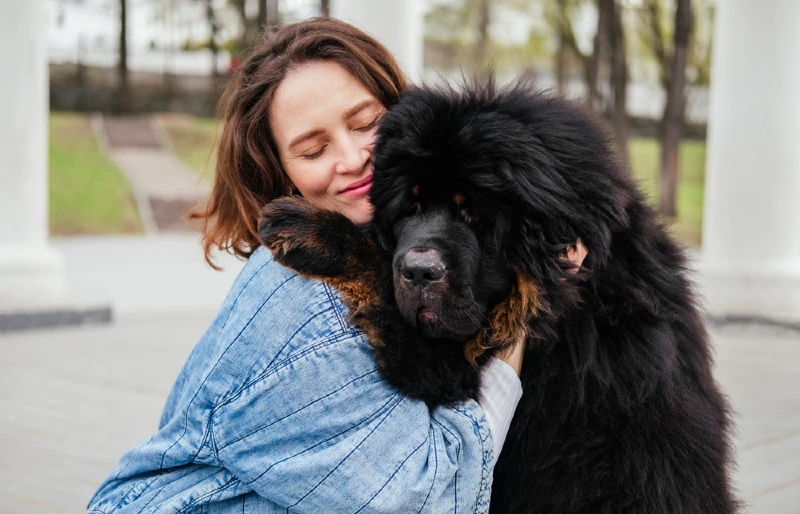13 Tibetan Mastiff Pros and Cons: Understanding the Breed

Updated on

Tibetan Mastiffs are massive and powerful dogs with a rich history in the Himalayas, their country of origin. They are an unforgettable dog breed with physical features resembling those of a lion and being heavier than a female black bear. They are mostly kept as guardian dogs.
But as protective as they may be of their families, you have to understand the benefits and drawbacks of the breed before adding one to your home.
This article will highlight the pros and cons of this breed for you to determine whether it’s ideal for your home.
The 7 Tibetan Mastiff Pros
Tibetan Mastiffs are described as highly intelligent and strong-willed.1 They are rated as number 147 in the list of the most popular dog breeds in the USA after gaining recognition from the American Kennel Club in 2006.2
Below are some pros of this breed.
1. Easily Lovable, Attracting Attention

If you are planning to adopt a Tibetan Mastiff puppy, you will have to be prepared for the attention you will receive from your community. The striking appearance and massive size of this dog breed will attract a lot of admirers and curious onlookers.
Since Tibetan Mastiffs are not seen very often, people will want to stroke their coats as well as ask to take pictures with the dog. And, of course, who wouldn’t enjoy such kind of admiration towards their pet?
2. Independent
Tibetan Mastiffs feature a strong independent streak. Some people may consider this as a negative, but it can also be a good thing because the dog can happily and comfortably lounge around your home without needing any sort of attention. This is convenient, especially in households where the owners lead very busy lifestyles.
3. Low Energy

Unlike other dog breeds, Tibetan Mastiffs do not require regular daily exercises. Sure, you can take it for daily leisure strolls around your neighborhood, but you won’t need all the other vigorous exercises that other dogs enjoy.
According to the AKC, Tibetan Mastiffs may also enjoy tasks such as patrolling their territory. Their low energy levels also give the dog a calm demeanor, and they don’t get boisterous among strangers.
4. Loyal
If you are looking for a loyal dog that will stay by your side through thick and thin, the Tibetan Mastiff is an ideal candidate. Once this dog creates a bond with the pet parents, it will stick with them for life, thus becoming a Velcro dog.
5. Guardians

The American Kennel Club proudly describes the Tibetan Mastiff as the “Guardian Dog Supreme”, and rightly so. These dogs were initially bred as working dogs whose primary objective was to protect livestock.
They tend to be very devoted to family members but very territorial and reserved with strangers. Their massive size should be enough deterrent for any unwanted visitors to a home. It also features a very loud bark to alert the owner of any intruders in its territory. They regularly patrol around fence lines when they are not sleeping.
6. Rarity
Some people take pride in owning rare items. Tibetan Mastiffs are some of the rarest dog breeds in the world. Pure Tibetan Mastiffs may be hard to find in their homeland but are even harder to find outside Asia. They also retail at a premium price tag, and you would be the only owner within your locality.
Most dog owners consider their rarity to be a perk. They are certainly not your typical dog, so you are not likely to bump into one around the dog park.
7. Sociable

Even though the breed standards may outline that Tibetan Mastiffs are aloof and reserved around strangers, they can warm up to new dogs and people with controlled socialization. Once they get used to new people, they will gladly let anyone stroke their thick and heavy fur. Even around new dogs, they will sniff and let them sniff back.
Keep in mind that most dogs are often intimidated by their sheer size, so they are likely to take snaps at your Tibetan Mastiff in a show of dominance. Fortunately, if your dog is properly socialized, it will just shrug off the attack and walk away.
The 5 Tibetan Mastiff Cons
These dogs may be gentle and loving but can also be very territorial and dangerous if not properly trained from an early age. This is perhaps why canine experts recommend that Tibetan Mastiffs are kept by owners with experience working with large dominant dog breeds.
Here are some cons about them worth noting.
1. Stubborn

It is not surprising that Tibetan Mastiffs are or can be a stubborn dog breed. Since they are strong-willed and independent dogs, it can be quite challenging to convince them to do your bidding. Granted, extensive training may make them more agreeable, but it can be uncooperative too.
Their stubbornness doesn’t necessarily stem from disobedience or insufficient training. Sometimes they may not just be bothered to rise to a task or do something they do not want to. One of the biggest challenges the owners of this breed go through is trying to get the dog inside at the end of the day.
2. Huge Size
As earlier mentioned, Tibetan Mastiffs are some of the largest dog breeds in the world. They can grow as tall as 24-29 inches tall and weigh as much as 70-150 pounds. While the size can be beneficial when protecting a home against intruders, it can also be a drawback.
For instance, they are likely to knock over furniture or small family members as they walk around. It can also be challenging trying to lift them, and they also take up half the couch space when they want to sit next to you.
Due to their massive size, they also require a lot of feeding. So, you should be prepared to foot hefty food bills if you want to own one.
3. Drool

If you are disgusted by dog drool, then a Tibetan Mastiff may not be ideal for your home. Sure, drool may be inevitable in all dogs, but these massive dogs tend to drool a lot, especially in hot weather.
Therefore, be prepared to deal with slobber on your furniture and clothes. Have a towel ready to wipe off the drool before the dog shakes it off and lands in some rather unexpected places. Also, consider buying a bib for your dog when going for walks to avoid covering people with drool.
4. Grooming
Despite having a thick and heavy fur coat, Tibetan Mastiffs are surprisingly moderate shedders throughout the year. They feature a double coat with a coarse, protective outer layer and a heavy soft undercoat.
However, once every year, Tibetan Mastiffs will shed their undercoat. This can be a very challenging season because you will have to brush your dog’s coat daily to get rid of dander and dead skin cells.
Experts recommend that you brush your dog’s coat at least 2–3 times every week and take him to a professional groomer after every 6-8 weeks. This not only requires you to set some time to keep up with your dog’s grooming, but it also requires money because professional groomers do not come cheap.
5. Barking

Tibetan Mastiffs have a very loud bark. They may not be noisy dogs, but their bark can be loud enough to be heard over a long distance. While the loud bark can be beneficial when attempting to thwart burglars or unwanted visitors with ill intentions, it can also be a nuisance, especially if the dog barks 24/7 at random people or animals walking outside your home.
Conclusion
Tibetan Mastiffs are protective, loyal, sociable, independent, and rare breeds that grab attention everywhere they go. However, they can also be stubborn, drool a lot, and bark too loudly. They are also moderate shedders that require frequent and regular grooming.
Owning this dog can be a challenging or rewarding experience. However, this will depend on how much time, money, and effort you are willing to dedicate toward their care and maintenance.
Featured Image Credit: Olga Aniven, Shutterstock












